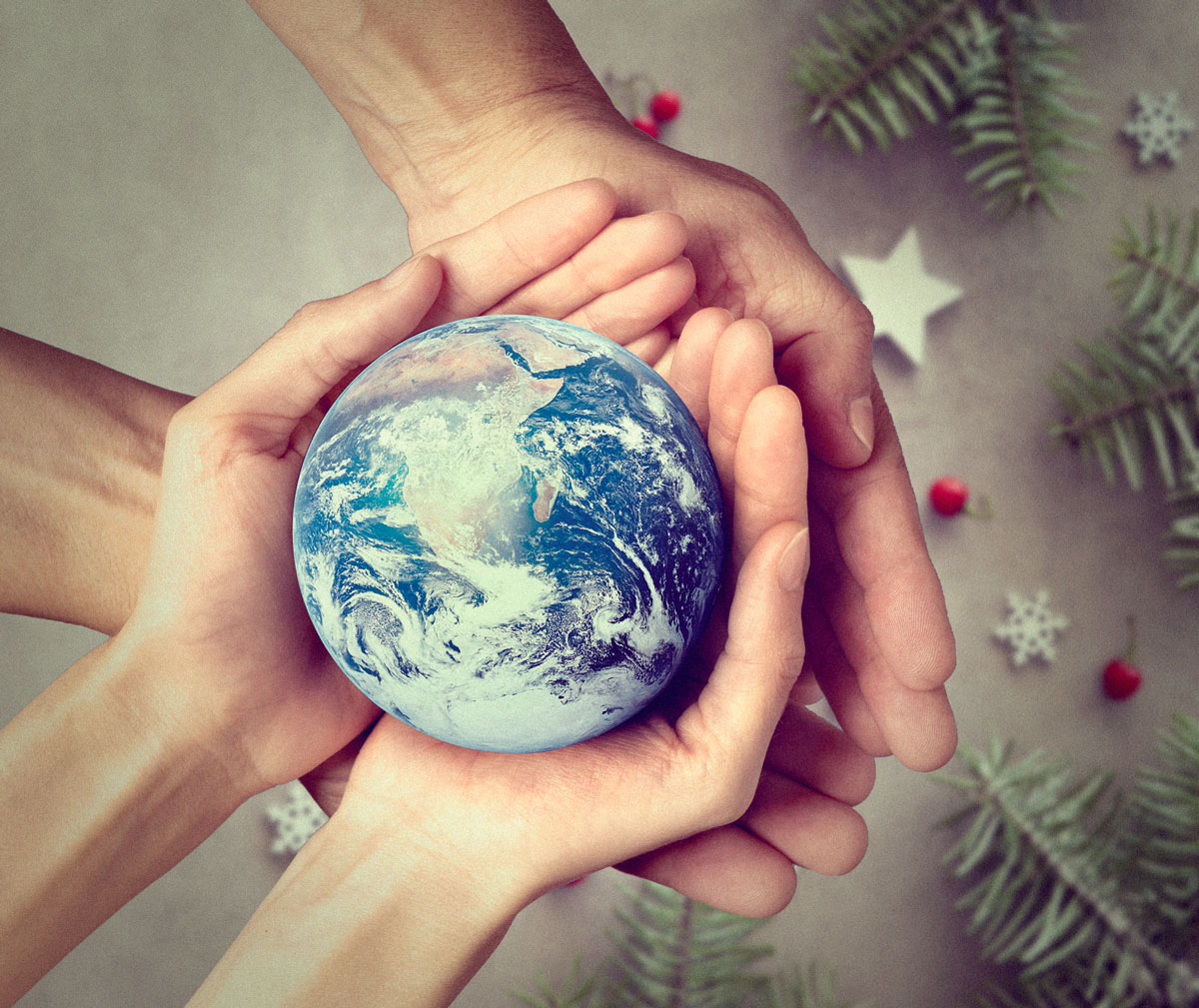
Our celebrations of Christmas and other seasonal holidays are an important part of life. Still, the holidays place extraordinary stress on people and the planet. A recent US study revealed that during the holiday season, each of us is responsible for an additional 1,400 pounds of carbon emissions, giving Mother Earth nearly 228,000 tons of greenhouse gases for Christmas! Yikes!
How can we make the holidays more sustainable? By simplifying our gift giving, entertaining, decorating, and travel. The holidays need not be an orgy of consumption and frantic activity. We’ll be healthier for it, and so will the planet
Gift giving
We’re conditioned to think that more is better, but one meaningful gift beats a pile of lesser items under the tree. A British study found that their relatively small nation throws away 230,000 tons of unwanted Christmas gifts every year. And we have four times the population! The manufacture and transport of those discards costs the environment dearly in terms of carbon emissions, raw materials, and groundwater.
Why not simplify gift giving while reducing environmental impacts by giving handmade gifts, such as knitting, original art, canned or baked goods, or homemade beer or wine? Organic materials such as cotton, hemp, silk, and wood are renewable and support sustainable industries. And when they eventually get thrown away, they decompose naturally, without toxic waste.
Consider gift certificates and coupons for services you or others can provide; grocery shopping, massages, respite for caregivers, snow removal, yoga classes, instruction in music, photography, weaving, pottery, etc.
You might also consider making donations to charitable or ecological groups, such as Friends of the Earth, Environmental Defense Fund, The Heifer Project, World Wildlife Fund, and countless other organizations, to honor those on your gift list, with no adverse impact on the environment.
If you do shop for gifts, support local businesses and artisans, especially those selling locally produced goods. Browse the thrift shops for gently used items, rather than new ones. Pass along your own treasures. Look for minimal packaging. Avoid non-biodegradable plastic products and packaging. When ordering online, favor smaller companies and items made in the US, to avoid overseas shipping.
Be mindful of waste
Make your own Christmas cards, using cards from previous years. Consider sending paperless holiday greetings via electronic media.
One British study found that their citizens toss more than 226,800 miles of wrapping paper during the holidays, enough to wrap around the planet nine times. With quadruple the population, that’s 36 times for the US. Consider reusable gift bags, instead of wrapping paper. Newly manufactured wrapping paper requires huge amounts of water and toxic dyes, so if you do purchase wrapping paper, look for 100% recycled. You can make your own from paper bags, newsprint, or magazine stock and you can reuse (or recycle) wrapping paper, ribbon, bows, and gift bags if you unwrap gifts carefully. This year’s Christmas cards can serve as next year’s gift tags.
To Tree or not to Tree?
Some people worry about the millions of live trees sacrificed each Christmas. Should we opt for a reusable artificial tree instead? The manufacture and delivery of a 6-foot artificial tree produces 88 pounds of carbon emissions, much more than a compostable live tree in a landfill or a tree that is burned. Artificial trees use non-renewable, non-bio-degradable petroleum, with a big carbon footprint for extraction, refining, manufacturing, and transportation.
Live trees require no mineral extraction or processing. As a farmed product, they are constantly replaced, with no net loss of carbon sequestration. Farmed trees do impact the environment due to water consumption, herbicides, pesticides, and inorganic fertilizers. Non-local trees add carbon in transport.
Some of us live in piñon/juniper forests, in need of thinning. True, these trees lack the idealized form of a commercially grown tree, but beauty is in the eye of the beholder. Cutting a wild tree reduces competition among remaining trees for water, nutrients, and sunlight, increasing resistance to infestations and disease and mitigating the intensity of wildfires. Younger specimens often have more pleasing, traditional shapes.
You hard-core earth-friendly types might save any necessary pruning until just before the holidays, taking an attractive branch inside for decoration as your “tree.”
A cut tree can be chipped for mulch, conserving water, after its prime time has passed. At a fire-safe distance from a residence, a spent tree provides shelter for birds and animals, increasing wildlife diversity and ecological balance.
Balled-and-burlapped trees from nurseries can be brought inside (briefly, to preserve dormancy), then returned to the outdoors to be planted as a permanent landscape feature, a property investment, and a net gain for the environment.
You can also decorate large houseplants like aloe and cholla cactus, last year’s poinsettia, or a potted indoor tree, like ficus, olive, juniper, or Norfolk pine.
Christmas lights
According to The Energy Saving Trust, the amount of carbon emitted to power Christmas lights each year is equal to that produced by 15,500 hot air balloons. Switching to low-energy, long-lasting LED lights can cut your energy bill by 90 percent. Simplify holiday lighting—no need to compete with your neighbors. And put your Christmas displays on a timer so they don’t burn all night long.
Food waste
In the UK, according to a University of Manchester study, excessive eating habits during the holidays create the same carbon footprint as 6,000 cars circling the globe. The Brits buy 80% more food over the Christmas season than the rest of the year. As in the US, much of that food goes to waste, increasing environmental impacts for no reason at all.
Travel
According to a 2018 study published in the journal Nature, vacation travel accounts for about eight percent of global greenhouse gas emissions, much of it during the holidays. Last year more than 112 million Americans engaged in holiday travel, even with pandemic restrictions. It’s important for families to be together, but think about if you really need to fly everyone to far-flung destinations.
There are countless ways to make the holidays more sustainable and less stressful. Why not adopt a few of these measures and see if it makes for a more joyful, meaningful season?
The information presented here was
gleaned from the following sources:
https://www.telesurenglish.net/news/Christmas-Carbon-Footprint-and-Its-Irreversible-Consequences-20191224-0020.html
https://www.sustainablebabysteps.com/green-christmas
https://www.countryliving.com/uk/homes-interiors/interiors/g25329535/eco-friendly-christmas-ideas-green-christmas/In the spirit of this article, these published books can be found on used books sites and thrift sites and ebay. We simply googled the titles and many options presented.
Other Resources:
A Greener Christmas, Edited by Sheherazade Goldsmith.
Green Christmas – How To Have A Joyous,
Eco-Friendly Holiday Season by Jennifer & Peter Sandler.
Author
-

Daniel Hutchison is executive director of the non-profit Localogy; moving passive consumers to be active producers of livelihoods and culture. .
View all posts



